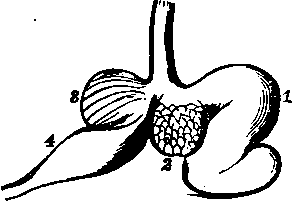64. The Form Of Digestive Tube
Description
This section is from the book "Animal Physiology: The Structure And Functions Of The Human Body", by John Cleland. Also available from Amazon: Animal Physiology, the Structure and Functions of the Human Body.
64. The Form Of Digestive Tube
The Form Of Digestive Tube, which has been briefly described, is that which is found in the human subject, but there is great variety in different animals. In certain fishes, the pipe fishes and others, the tube is straight, but in most of them it is convoluted; and in all it is wide from the throat to the pylorus, then constricted, and again widened towards the termination; this latter enlargement being evidently the representative of the large intestine. A valve even exists at the entrance into the large intestine in many fishes. Thus it will be seen that already in the lowest division of vertebrate animals, the digestive tube is divisible into three great parts. In mammals neither the part above the pylorus nor that below the ileo-colic valve has a uniform breadth; the stomach is separated from the pharynx by a narrow aesophagus; and the caecum is in some instances greatly larger than the rest of the great intestine. The stomach and caecum are the parts which undergo the most remarkable complications. The human stomach is an instance of the simplest and typical form of the organ in mammals; but in various animals belonging to widely separate orders, remarkable complications exist, e.g., in the camel, the kangaroo, the cetacea, the peccary, and certain monkeys.
Probably the arrangement most interesting to the general reader is the ordinary ruminant stomach, which is divided into four compartments. When the ruminant is feeding, the food passes into a large compartment, the paunch, which is the cardiac extremity of the stomach, elongated and folded on itself in foetal life, and subsequently much expanded. When the animal lies down to ruminate, the contents of the paunch are propelled in successive portions into a small compartment called the reticulum, from the honey-combed appearance of its walls, and placed to the front below the oesophagus, and by it are returned to the mouth in separate pellets. After being a second time masticated, the food is again swallowed, and being prevented by the closure of a ring of muscular fibres from re-entering the first two compartments, it falls into the third, the omasum, which lies behind the second, and is of similar size, but has its mucous membrane thrown into numerous broad folds which separate up the bolus, and allow it to pass in portions gradually into the fourth compartment or abomasum, which is the pyloric end of the stomach, and the only part furnished with a highly vascular and glandular mucous membrane.

Fig. 62. Ruminant Stomach, diagrammatic view.
The caecum may acquire a great development even in animals in which the stomach is simple. This is the case in the rabbit and in the horse, in both which it has great width and length. Generally, the alimentary tube is much more elongated and complex in vegetable-feeders than in carnivora.
Continue to:
